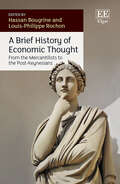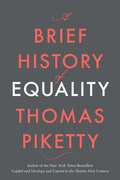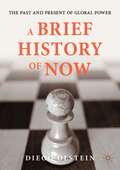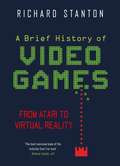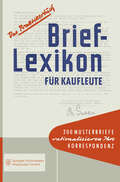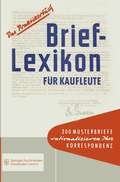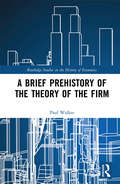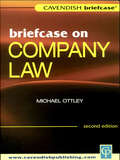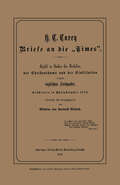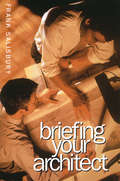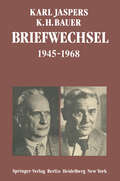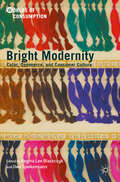- Table View
- List View
A Brief History of Economic Thought: From the Mercantilists to the Post-Keynesians
It is now widely acknowledged that history is useful, even essential, because it helps us predict the future. The history of ideas in economics, as in other fields of inquiry, plays an important role in enlightening current researchers as they endeavour to understand contemporary events and anticipate the future of human societies. This book brings together a fine collection of chapters that span contributions from forgotten classics to the most recent new thinking about critical issues such as growth, wealth, its creation and its distribution among members of society. It is A Brief History of Economic Thought, but it will certainly go a long way in helping undergraduate students and other researchers who are curious about the evolution of economic ideas over the last five centuries. Chapters offer discussions on the main tenets of post-Keynesian economics, and focus on issues of growth, wealth and income distribution. The debate on the role of government versus the market is brought to the fore within the context of economic thought from the Physiocrats to the post-Keynesians.The editors have created an essential read for scholars and students interested in the history of economic thought and post-Keynesian economics.
A Brief History of Equality
by Thomas PikettyThe world’s leading economist of inequality presents a short but sweeping and surprisingly optimistic history of human progress toward equality despite crises, disasters, and backsliding. A perfect introduction to the ideas developed in his monumental earlier books. It’s easy to be pessimistic about inequality. We know it has increased dramatically in many parts of the world over the past two generations. No one has done more to reveal the problem than Thomas Piketty. Now, in this surprising and powerful new work, Piketty reminds us that the grand sweep of history gives us reasons to be optimistic. Over the centuries, he shows, we have been moving toward greater equality. Piketty guides us with elegance and concision through the great movements that have made the modern world for better and worse: the growth of capitalism, revolutions, imperialism, slavery, wars, and the building of the welfare state. It’s a history of violence and social struggle, punctuated by regression and disaster. But through it all, Piketty shows, human societies have moved fitfully toward a more just distribution of income and assets, a reduction of racial and gender inequalities, and greater access to health care, education, and the rights of citizenship. Our rough march forward is political and ideological, an endless fight against injustice. To keep moving, Piketty argues, we need to learn and commit to what works, to institutional, legal, social, fiscal, and educational systems that can make equality a lasting reality. At the same time, we need to resist historical amnesia and the temptations of cultural separatism and intellectual compartmentalization. At stake is the quality of life for billions of people. We know we can do better, Piketty concludes. The past shows us how. The future is up to us.
A Brief History of Now: The Past and Present of Global Power
by Diego OlsteinExploring the rise and fall of global power from the mid-nineteenth century, this book tracks the long and interrelated trajectories of the most serious challenges facing the world today. Although at first the urgency of the coronavirus outbreak in 2020 seemed to take precedence over other global problems such as socioeconomic inequality and climate change, it has ultimately exacerbated these issues and created opportunities to address them boldly and innovatively. A Brief History of Now provides a bird’s-eye view of world hegemony, economic globalization and political regimes as they have evolved and developed over the last two hundred years, providing context and insights into the forces which have shaped the Western world. Presented in an accessible and engaging narrative, the book addresses key contemporary challenges and explores the repercussions of a technological revolution, the potential instability of democracy over the coming years, and the urgent struggle to tackle climate change. With his book, Diego Olstein helps to answer pressing questions about our world today and provides a roadmap for analysing future trajectories.
A Brief History of Price
by J. HartwickThis book is an attempt to explain to the layperson what contemporary economics is about. It starts on the assumption that most economics is just refined common sense and clearly explains the key ideas associated with each issue. All the main topics of academic economics are considered: the theory of individual choice, the labour market, the competition between firms, international trade, economic growth, the stock market, unemployment, and money. The general principles are sketched first without maths or diagrams, and then discussed in the context of topical problems such as the collapse of communism in Eastern Europe, the lack of development in the third-world countries, the contrast between market forces and the protection of the environment, showing how economics is not necessarily a dry academic pursuit.
A Brief History Of Video Games: From Atari to Virtual Reality (Brief Histories)
by Rich Stanton'Stanton writes with terrific verve and precision . . . his understanding of the seductive pleasures of gaming takes us right to its heart.'Maria Bustillos, Times Literary Supplement'The best overview book of the industry that I've read.'Andrew Liptak, io9From the first wood-panelled Pong machines in California to the masterpieces of engineering that now sit in countless homes all over the world, A Brief History of Video Games reveals the vibrant history and culture of interactive entertainment. Above all, this is a book about the games - how the experience of playing has developed from simple, repetitive beginnings into a cornucopia of genres and styles, at once utterly immersive and socially engaging. With full-colour illustrations throughout, it shows how technological advances have transformed the first dots and dashes of bored engineers into sophisticated, responsive worlds that are endlessly captivating. As thrilling and surprising as the games it describes, this is an indispensable read for anyone serious about the business of having fun.
Brief-Lexikon für Kaufleute: Ein Handbuch für die rationelle Erledigung der Korrespondenz (Brief-Lexikon-Reihe)
by Betriebswirtschafts-MagazinBrief-Lexikon für Kaufleute: Ein Handbuch für rationelle Erledigung der Korrespondenz (Brief-Lexikon-Reihe)
by Betriebswirtschafts-MagazinBrief-Lexikon für Kaufleute: Ein Handbuch für die rationelle Erledigung der Korrespondenz (Brief-Lexikon-Reihe)
by Schrifleitung des Wirtschafts-MagazinsBrief-lexikon für Kaufleute: Ein Handbuch für die rationelle Erledigung der Korrespondenz (Brief-Lexikon-Reihe)
by Verlag Dr. Th. Gabler GmbHBrief-Lexikon für Kreditsachbearbeiter: Ein Handbuch für die bankmäßige Kreditbearbeitung (Brief-Lexikon-Reihe)
by Jürgen W. WerhahnBrief-Lexikon für Kreditsachbearbeiter: Ein Handbuch für die bankmäßige Kreditbearbeitung (Brief-Lexikon-Reihe)
by Jürgen W. WerhahnA Brief Overview of China’s ETS Pilots: Deconstruction and Assessment of Guangdong’s Greenhouse Gas Emission Trading Mechanism
by Daiqing Zhao Wenjun Wang Zhigang LuoThis book systematically introduces readers to the framework of China’s ETS pilots, exploring their design and operating process, the current state of the carbon market, and various barriers encountered. To do so, it deconstructs the Guangdong ETS, which is the largest and most representative of China’s seven ETS pilots. The book subsequently describes and evaluates all seven pilots in terms of their efficiency, macro and micro effects, the method involved in the DEA model, the CGE model, and cost-benefit analysis. In turn, in the assessment section it demonstrates how some ETS pilots have failed to control carbon emissions due to inordinately high emissions quotas issued by the local government etc. Further, it argues that ETS should focus on those industries with large emissions and high mitigating potential for the time being, and then gradually expand the scale of its coverage.As China’s national ETS is slated for launch on the basis of the lessons learned from the ETS pilots, the book offers a timely and valuable resource for all those who want to understand and forecast the development of China’s ETS. It includes a wealth of descriptions and explanations of Chinese government policies involving carbon emissions control, making it a unique resource.
A Brief Prehistory of the Theory of the Firm (Routledge Studies in the History of Economics)
by Paul WalkerThe theory of the firm did not exist, in any serious manner, until around 1970. Only then did the current theory of the firm literature begin to emerge, based largely upon the work of Ronald Coase and to a lesser degree Frank Knight. It was work by Armen Alchian, Robert Crawford, Harold Demsetz, Michael Jensen, Benjamin Klein, William Meckling and Oliver Williamson, among others, that drove the upswing in interest in the firm among mainstream economists. This accessible book provides a valuable overview of the ‘prehistory’ of the firm. Spanning an impressive timeline, it delves into Antiquity, the Medieval era, the pre-classical economics period and the 19th and 20th centuries. Next, the book traces the theoretical contributions from pre-classical, classical and neoclassical economics. It will be illuminating reading for students and researchers of the history of economic thought, industrial organization, microeconomic theory and business history.
A Brief Prehistory of the Theory of the Firm (Routledge Studies in the History of Economics)
by Paul WalkerThe theory of the firm did not exist, in any serious manner, until around 1970. Only then did the current theory of the firm literature begin to emerge, based largely upon the work of Ronald Coase and to a lesser degree Frank Knight. It was work by Armen Alchian, Robert Crawford, Harold Demsetz, Michael Jensen, Benjamin Klein, William Meckling and Oliver Williamson, among others, that drove the upswing in interest in the firm among mainstream economists. This accessible book provides a valuable overview of the ‘prehistory’ of the firm. Spanning an impressive timeline, it delves into Antiquity, the Medieval era, the pre-classical economics period and the 19th and 20th centuries. Next, the book traces the theoretical contributions from pre-classical, classical and neoclassical economics. It will be illuminating reading for students and researchers of the history of economic thought, industrial organization, microeconomic theory and business history.
Briefcase on Company Law (Briefcase Series)
by MIchael OttleyThe Briefcase series is designed specifically with the time-pressed student in mind. It provides concise case summaries within each subject area of an undergraduate law degree, accompanied by relevant legislation. A handy reference tool, the book assists the reader to commit the content of each subject to memory. This title covers the four main areas of company law: the constitution, formation and personality of a company; corporate governance; corporate finance; and insolvency and company charges. The second edition has been updated to include recent important cases, including the House of Lords decision in Johnson v Gore Wood - (minority shareholder action) Phillips v Brewin Dolphin Bell Lawrie Ltd - (transactions at an undervalue) O'Neill v Phillips - (unfair prejudicial conduct) Williams v Natural Life Health Foods Ltd - (liability in negligence) the Privy Council decision in Agnew v Commissioner of Inland Revenue - (company charges).
Briefcase on Company Law (Briefcase Series)
by MIchael OttleyThe Briefcase series is designed specifically with the time-pressed student in mind. It provides concise case summaries within each subject area of an undergraduate law degree, accompanied by relevant legislation. A handy reference tool, the book assists the reader to commit the content of each subject to memory. This title covers the four main areas of company law: the constitution, formation and personality of a company; corporate governance; corporate finance; and insolvency and company charges. The second edition has been updated to include recent important cases, including the House of Lords decision in Johnson v Gore Wood - (minority shareholder action) Phillips v Brewin Dolphin Bell Lawrie Ltd - (transactions at an undervalue) O'Neill v Phillips - (unfair prejudicial conduct) Williams v Natural Life Health Foods Ltd - (liability in negligence) the Privy Council decision in Agnew v Commissioner of Inland Revenue - (company charges).
Briefe an die „Times”: Replik in Sachen des Verkehrs, des Christenthums und der Civilisation contra englischen Freihandel
by Wilhelm Von Kardorff-WabnitzBriefing Your Architect
by Frank SalisburyThis book sets out the essential activities and inter-relationships involving the client organization and multi-disciplinary design team as they progress through each phase of the job. It guides the client through the preliminary steps needed to start up work; seeking out and appraising a site, studying the feasibility of all ideas and proposals, and showing how to work with all architects and specialist consultants. The tasks to be performed by both architect and client, as well as consultants, are clearly set out, together with appropriate methods of working together until the building design drawings are completed. The book is arranged so that the information relevant to each stage of work can be checked as the project develops. Detailed sequential activity tables and checklists are included for this purpose.This key publication fulfils a vital need for clients who will be enabled to progress the building project more efficiently with the guidance provided. Frank Salisbury is a practising architect and lecturer in architecture for the University of Wales Associate College at Wrexham. He designed many important public buildings during his career with Cheshire County Council's Department of Architecture and as Assistant County Architect, led architectural and multidisciplinary teams in the realization of a great many high quality building projects.
Briefing Your Architect
by Frank SalisburyThis book sets out the essential activities and inter-relationships involving the client organization and multi-disciplinary design team as they progress through each phase of the job. It guides the client through the preliminary steps needed to start up work; seeking out and appraising a site, studying the feasibility of all ideas and proposals, and showing how to work with all architects and specialist consultants. The tasks to be performed by both architect and client, as well as consultants, are clearly set out, together with appropriate methods of working together until the building design drawings are completed. The book is arranged so that the information relevant to each stage of work can be checked as the project develops. Detailed sequential activity tables and checklists are included for this purpose.This key publication fulfils a vital need for clients who will be enabled to progress the building project more efficiently with the guidance provided. Frank Salisbury is a practising architect and lecturer in architecture for the University of Wales Associate College at Wrexham. He designed many important public buildings during his career with Cheshire County Council's Department of Architecture and as Assistant County Architect, led architectural and multidisciplinary teams in the realization of a great many high quality building projects.
Brieflexikon für Kaufleute: 200 Musterbriefe zur Rationalisierung der Korrespondenz
by Springer FachmedienBriefpoststrategien in Europa: Handlungsoptionen europäischer Briefpostgesellschaften im zunehmend dynamischen Wettbewerb (Edition KWV)
by Karsten SchwarzDer europäische Briefmarkt befindet sich im Umbruch: Nachdem über Jahrhunderte hinweg die staatlich garantierten Postmonopole ein profitables Auskommen sicherten, steht die Zukunft im Zeichen der Liberalisierung. Gleichzeitig sehen sich die Postgesellschaften mit einer zunehmenden Bedrohung durch elektronische Kommunikationsmedien konfrontiert – allen voran Internet und E-Mail. Diese doppelseitige Bedrohung führt zu Handlungsdruck auf die etablierten Gesellschaften sowie zur Frage nach der „richtigen“ strategischen Ausrichtung.Das Buch dient der wissenschaftlich fundierten Beantwortung dieser Fragestellung. Es zeigt detailliert auf, welche Bedrohungen, aber auch welche Chancen sich für die europäischen Postgesellschaften aus den gegenwärtig beobachtbaren Marktveränderungen ergeben. Dabei werden konkrete strategische Gestaltungsempfehlungen auf Basis des Konfigurationsansatzes sowie ein neues Modell des Übergangs zwischen diesen Konfigurationen entwickelt. Es wird deutlich, dass gerade die kleineren Postgesellschaften vor immensen Herausforderungen stehen, im zukünftigen Wettbewerb zu bestehen: Ihnen bleiben breit angelegte Expansionsmöglichkeiten verwehrt. Auf Seiten der großen Gesellschaften wird von einer deutlichen Ausweitung internationaler Expansionsaktivitäten ausgegangen, an deren Ende ein Margenverfall auf breiter Front unausweichlich scheint.Das Buch wendet sich an Dozenten und Studenten der Betriebswirtschaftslehre mit den Schwerpunkten Logistik, Supply Chain Management und Unternehmensführung sowie an interessierte Führungskräfte der Logistikbranche.
Bright Marketing for Small Business (Startups Ser.)
by Robert CravenLook at your business through the eyes of your customer.Why should people bother to buy from you when they can buy from the competition? How can your marketing reach out to your customers? And what makes your business different from the rest?As a small business owner these are questions you will have to be able to answer confidently and assertively to make your business a success. You probably won't be the person marketing the product, but you are the person who best understands your business and your sales proposition and you need to ensure your marketing activity is aligned to your business plan. Bright Marketing for Small Business understands this and gives company owners and directors confidence to implement a hooked up marketing plan from research to sales. Author Robert Craven helps you pinpoint: * Who you want to be communicating with (your target audience) * What method of communication is most suitable (email, letter, phone call, Twitter?) * What your message should be (your sales proposition) Remember, in today's increasingly competitive marketplaces, people have a choice. They can buy from the 'me too' mediocrity or they can buy from the market leaders. Whether you trade locally, regionally, nationally or internationally, Bright Marketing for Small Business helps you look at your business through the eyes of your customer and put yourself ahead of the competition.Robert Craven has an extensive and practical experience of business marketing and currently the managing director of the Directors' Centre, Robert writes in an informal style which makes Bright Marketing both practical and inspiring.
Bright Modernity: Color, Commerce, and Consumer Culture (Worlds of Consumption)
by Mark StonemanColor is a visible technology that invisibly connects so many puzzling aspects of modern Western consumer societies—research and development, making and selling, predicting fashion trends, and more. Building on Regina Lee Blaszczyk’s go-to history of the “color revolution” in the United States, this book explores further transatlantic and multidisciplinary dimensions of the topic. Covering history from the mid nineteenth century into the immediate past, it examines the relationship between color, commerce, and consumer societies in unfamiliar settings and in the company of new kinds of experts. Readers will learn about the early dye industry, the dynamic nomenclature for color, and efforts to standardize, understand, and educate the public about color. Readers will also encounter early food coloring, new consumer goods, technical and business innovations in print and on the silver screen, the interrelationship between gender and color, and color forecasting in the fashion industry.
